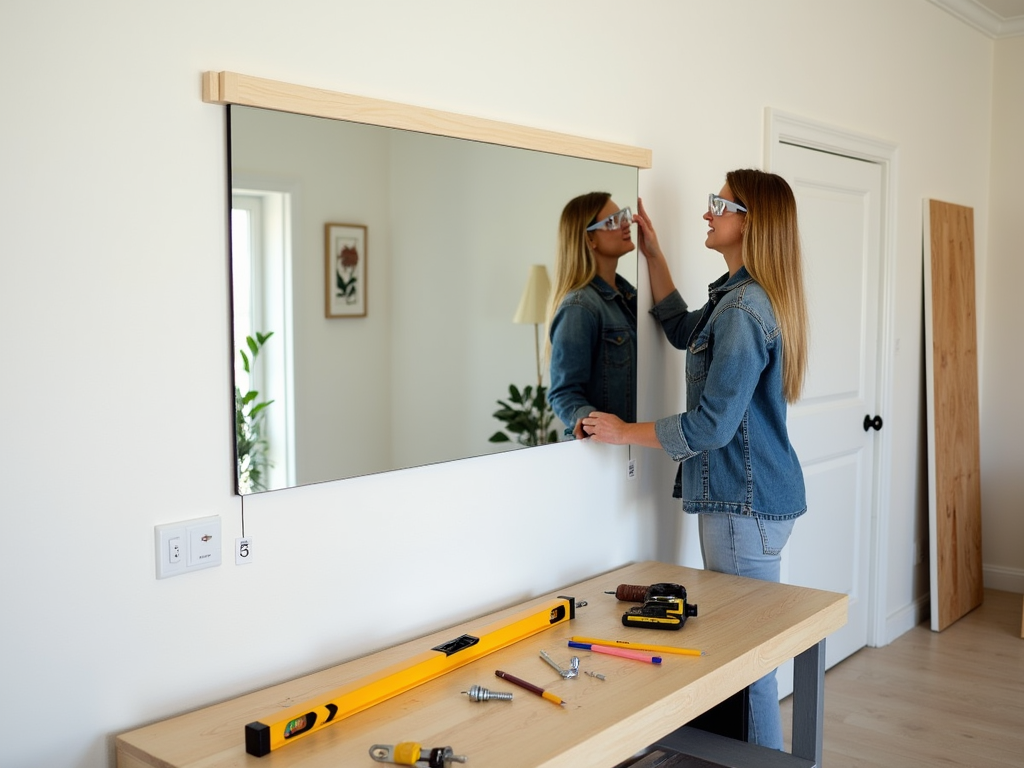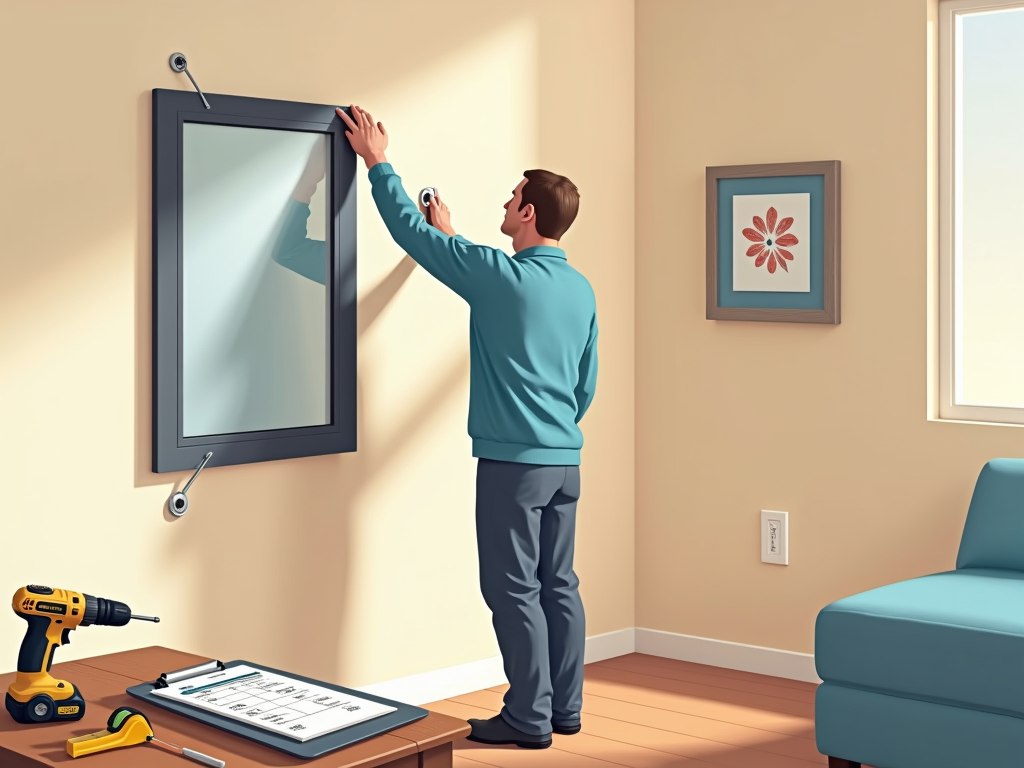
Hanging a heavy mirror demands precision, reliable support, and attention to safety. Selecting the right hardware and ensuring strong anchoring points can prevent mishaps and help create a secure, polished result.
Key Tips to Follow:
- Secure your mirror into wall studs whenever possible for the strongest hold. A stud finder is a handy tool to pinpoint their location behind your wall.
- Use hardware specifically rated for your mirror’s weight. Consider options like French cleats or heavy-duty J-hooks for larger, heavier mirrors that need substantial support.
- If studs aren’t accessible, opt for sturdy anchors. For drywall, toggle bolts are a smart choice, while molly bolts work well in plaster walls.
- Take the time to measure carefully and confirm alignment with a reliable level. This extra step ensures the finished look is both straight and professional.
- Don’t overlook safety. Protect your eyes with safety glasses and avoid tackling a heavy mirror alone—having a helper can make installation easier and safer.
Start with Studs: The Secret to a Secure Hang
The safest way to hang a heavy mirror is by anchoring it into wall studs. These provide the strength a hefty mirror demands, keeping both your wall and mirror safe. Most studs are spaced 16 inches apart on center, but older homes may stretch that to 24 inches.
Grab a stud finder to locate them. Make sure it’s calibrated correctly, then slide it across the wall. When it signals a stud, mark the spot lightly with a pencil. This is where your screws should go. Don’t overlook the term “on center”—it describes the spacing between the midpoints of adjacent studs. Double-check measurements since stud placement can be inconsistent in older construction.
If you’re curious about decor tricks beyond hanging, check out how to make a picture frame for matching accents!
Choosing the Right Hardware for Your Mirror’s Weight
Picking hardware that matches or exceeds your mirror’s weight is critical. Start by checking its weight—this guides your decisions. For mirrors up to 50 lbs, D-rings paired with heavy-duty wire work well. But if you’re hanging something heavier, look at options like French cleats or J-hooks. They’re built for larger loads and can spread the weight for better stability.
Always ensure the hardware is rated for more than the mirror’s actual weight. Manufacturers often print these ratings directly on the packaging, so double-check before buying. It’s better to play it safe to avoid accidents or damage. For smaller mirrors, D-rings keep things clean and straightforward. With heavier pieces, the sturdiness of French cleats makes them a solid go-to.
Exceeding hardware limits isn’t worth the risk—it compromises the safety of both your mirror and anyone nearby.
If You Can’t Find a Stud: Using Wall Anchors Safely
Wall anchors are a great option if there’s no stud where you want to hang your heavy mirror. Different anchors work best depending on your wall material. For drywall, toggle bolts are your go-to option. Plaster or hollow walls, on the other hand, are better suited to molly bolts. Save plastic expansion anchors for lightweight objects—they’re not strong enough for heavy mirrors.
Using Toggle Bolts
To use toggle bolts, follow these steps:
- Drill a hole through the wall slightly larger than the closed wings of the bolt.
- Insert the bolt with the wings closed.
- Once it’s through, the wings will open behind the wall.
- Tighten the bolt to secure it.
Ensuring Anchor Safety
Always ensure your anchor’s weight capacity matches your mirror. Keep a chart handy if you’re unsure. Avoid using weak anchors like plastic options. They might fail, leaving your mirror at risk. For lighter décor, check out how to make a picture frame for creative ideas.

Measure Twice, Drill Once: Planning for Perfect Placement
Accurate planning makes a big difference when hanging a heavy mirror. Start by measuring the mirror’s width, then divide it in half. This gives you the center point. Mark that on the wall at the height you want.
Next, find the distance between your mirror’s hanging hardware, whether it’s D-rings or wire. Transfer those measurements to the wall. Use a level to ensure everything will hang straight. Don’t skip this step—crooked mirrors are frustrating to fix.
After marking, check all your measurements again. One quick double-check can save you from drilling mistakes or unnecessary holes. When everything lines up, you’re ready to secure the mirror with confidence. A little extra time in prep ensures a polished and professional look every time. For a DIY touch, you can even learn how to make a picture frame to accent other decor in your room.
Safety First: Protecting Yourself and Your Walls
Always start with safety glasses before grabbing that drill. Flying debris isn’t just an annoyance; it can seriously hurt your eyes. Trust me, they’re an absolute must. While prepping, use the right drill bit for your wall type. For example, if you’re drilling into brick, grab a masonry bit—standard ones won’t cut it, literally or otherwise.
If you’re worried about your heavy mirror accidentally shifting over time, earthquake putty is a fantastic little helper. It’s smart to use on the bottom edges of the mirror for added stability, especially in areas prone to vibrations or minor quakes. It’s quick peace of mind for something as valuable as your mirror.
Getting a friend involved here is a game changer. Lifting and positioning a heavy mirror on your own can ruin your walls—or worse, hurt you. A helper ensures even placement and prevents accidents like cracked drywall or strained backs. Two hands steadying the mirror while you confirm its position make all the difference.
Don’t skimp on these measures. Reliable prep keeps your walls and the mirror looking pristine. If you’re also looking into how to protect the style around it, picking complementary pieces can elevate the room. Check out some tips on making a picture frame for surrounding decor ideas!
Sources:
This Old House – “How to Find a Wall Stud”
Family Handyman – “Types of Wall Anchors”
